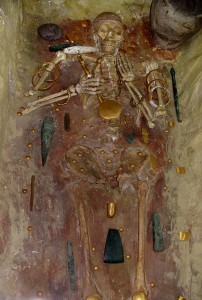Varna Penis Sheath

The cemetery of Varna, Bulgaria is situated on the Black Sea coast. It dates to the Copper Age or Chalcolithic (late 6th millennium-5th millennium BC). The site was excavated in the 1970s and was immediately recognised as being significant as probably the earliest evidence for gold working in prehistoric Europe (Renfrew 1986). Gold is used for a variety of forms including dress decorations and ornaments and as coverings for particular parts of the body, most famously the penis sheath of gold from grave 43, Varna.
It is easy for us to recognise the value of gold, but how important was gold in this early period of prehistory? Was it simply a valuable (Renfrew 1986), or does it relate to other aspects of belief such as political and cosmological power (Chapman 2002)? The Varna site not only allows us to consider the development of early technology, but also helps us consider the extensive networks of interaction, for example between Bulgaria and France, developed in prehistory (Chapman 2013).
Reading
Chapman, J. 2002. Colourful Prehistories, in A. Jones and G. MacGregor (eds.),Colouring the Past. Oxford: Berg, 45-72.
Chapman, J. 2013. From Varna to Brittany via Csőszhalom — Was There a “Varna Effect”? in A Anders and G. Kulcsárwith, G. Kalla, V. Kiss and G. V. Szabó (eds) Moments in time. Papers Presented to PálRaczky on his 60th Birthday. Budapest: L’Harmattan. [Blackboard Week 3 – pdf]
Renfrew, C. 1986. Varna and the emergence of wealth, in A. Appadurai (ed.), The social life of things, 141-68. Cambridge: Cambridge University Press.
